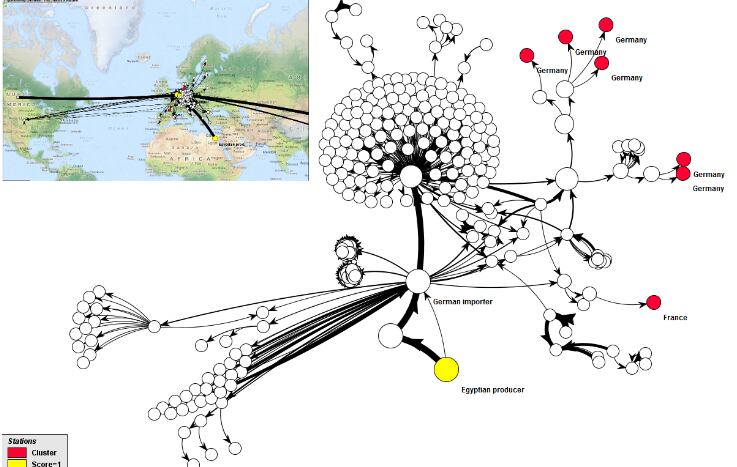The agreement makes available grants of up to €1.2m covering additional staff, software developments and travel costs.
The partnership is for four years and the number of grants is expected to be about eight.
It will further develop the software according to the needs of outbreak investigations in Europe so it is available to other EU Member States (MS).
Two examples of use
FoodChain-Lab is open-source software developed during the outbreak of Shiga toxin-producing E. coli O104:H4 in Germany in 2011.
It was able to identify the source of the outbreak as fenugreek seeds imported from Egypt.
It was also applied during the Hepatitis A outbreak in 2013/14 which had more than 3,000 ‘stations’ from where data was obtained. Finally two scenarios were identified as the possible common source.
The software provides data management, validation, enrichment and visualization features as well as interactive analysis and reasoning methods.
For each product (food item or ingredient) and each station (e.g. producer, restaurant) scores are computed to estimate the likelihood that the product/station is related to a contamination event (e.g. causing an outbreak).
The free software also allows simulations based on cross contamination during production, processing or geographical parameters.
Guidance on trace back and forward
Experience gained using the tool will feed into EFSA guidance for tracing back and forward in food and feed-borne incidents.
A draft of a first part, the proposal for a data structure, will be released soon for public consultation.

During the planning phase four areas for collaboration were selected: Tracing the food chain, establishing a model repository, testing uncertainty analysis and networking as crisis preparation.
EFSA told FoodQualityNews it was establishing partnerships with several Member States to avoid doubling of work and infrastructure.
“Funding is only one aspect. More important is the collaboration by bringing experience together, combining existing instruments, projects and exchange of staff.
“During the collaboration project several workshops, network meetings and newsletters will be provided to a wider European audience. The results will be finally available to all MS.”
The agency is establishing a repository for all evidence and supporting materials used in food and feed safety risk assessments.
This could be datasets, grey literature, protocols and models used in risk assessments and should supplement publication databases and official data sources, e.g. EUROSTAT.
“The collaboration will bring both aspects together and will define a meta language to store the models in the repository in an executable way. The task is not only to provide the models, but to enable the users in the MS also in running the predictive models,” said EFSA.
“The same principle applies for investigations of foodborne diseases by tracing back the source of contamination in the food supply chain during outbreaks.”
Adapting the software
EFSA and the BfR collaborated during the E. coli (STEC) outbreak that started in 2011 in Germany and the Hepatitis A outbreak in 2013 in Italy.
“The BfR software tool for tracing was continuously adapted to fit the needs of the outbreaks. A systematic review on the tracing methodologies is planned for the EFSA Guidance development.
“The task of the collaboration is to streamline both approaches and ensure that with the guidance an appropriate software tool will also be available to the MS.”
EFSA said tracing will always be in cooperation with industry using a variety of ERP (Enterprise Resource Planning) systems with such components but authorities have specific requirements for tools that can handle incomplete or imprecise data.
The agency added there are not many tools available specifically designed for authorities, so many MS are lacking appropriate systems.
“At the moment EFSA is using the tool when analysing investigations in multi-national outbreaks, because EFSA is mandated by the European Commission to coordinate and harmonise the data collection in Europe on request.
“The tool is perfectly able to handle this diversity of inputs and supply valuable outputs. Of course the harmonisation of the MS systems would be a benefit but in fact this may not be reason enough to change the systems in the MS.
“Therefore EFSA will establish a Tracing Network, where the specificities of the MS are discussed. The task of the collaboration is also to adapt the tool to all MS that they can use it or stay with their existing system.”
